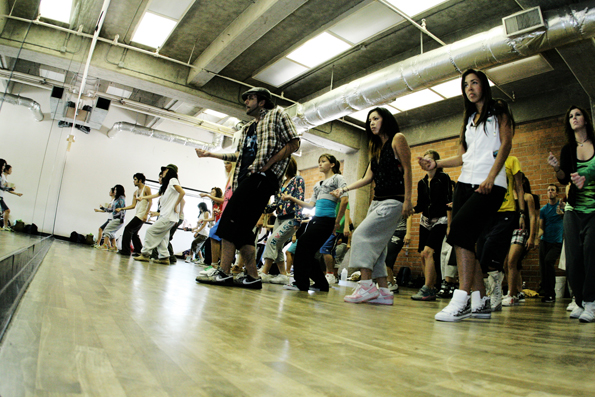The search for a great teacher is something that every dancer understands, but what do the teachers say?
By Paul Ransom.
From his Los Angeles headquarters Bill Prudich says it simply. “As an instructor you must always remember that it is your job to communicate what you want and explain it in a way that the student can understand. If a student fails to understand, it is your responsibility to adjust. Find the way to reach them.”
Of course, Prudich should know, having taught dance since 1984 and run the Edge Performing Arts Center since 1992. “Many ‘teachers’ show their work and do not explain how to achieve it,” he observes. “Counts are not enough if you wish to be a true teacher.”
Like all artists dancers thrive on great mentoring; but many dancers will recall childhood years of ironically forgettable classes in church halls and uninspiring studio spaces. Yet it is equally true to suggest that there is no one way to teach.
Across America from Bill Prudich, Tracie Stanfield is recognised as one of the very best dance teachers in New York City and her perspective is more exact. “I believe it’s my duty to keep my dancers strong and safe,” she begins. “I work to understand the body and the mechanics of what I’m asking of my dancers. It’s easy to think of cool, crazy moves but the challenge lies in keeping the dancers safe and injury free.”
However, any teacher will tell you that it’s also important to keep things fresh. Whilst drill and basics are clearly necessary the teacher is always challenged to maintain student focus.
“I like to shake up my students by changing the music to a radically different style in my choreographed warm up,” Stanfield says. “This knocks them out of their comfort zone; and once I have them in a fully concentrated state I change the ‘front’ of the room and have them facing the back of the studio with no mirrors. It’s amazing how focused we become on feeling when the mirror is taken away.”

Sarah Boulter's dance students perform
As the director of Sydney based school Ev & Bow, Australian dancer Sarah Boulter has worked with the likes of Celine Dion and Meryl Tankard. Her best advice for teachers trying to keep it fresh is simple. “Go to the theatre as often as possible and go see things you wouldn’t usually see.”
Freshness aside, the other great challenge for dance teachers is the balance between technique and individual expression. Whereas some modern ‘street’ forms naturally allow for greater diversity, at the other end of the spectrum ballet is renowned for its technical precision.
Melbourne based instructor and former Australian Ballet soloist Rhyl Kennell still puzzles over the balance after more than forty years as a dancer and Cecchetti Method teacher. “Being a classical ballet teacher I feel that a good solid technique is essential for a career in dance,” she explains, “and yet I do not want to squash any individual expression. However, too much expression at the expense of technique is not conducive to creating an artist.”
Back in LA, Bill Prudich works with a more modern curriculum. “Today’s most popular commercial dance styles are just that, mostly style,” he declares. “Tricks and stunts are prevalent and core technique suffers because of it … don’t get me wrong, I love these forms but feel that there is too much emphasis on expression and not enough on the technical core ‘vocabulary’.”
Tracie Stanfield echoes this sentiment. “My students are so sick of me saying this but expression is not communication,” she underlines. “Expressing yourself in dance may not have anything to do with communicating to the audience.”
Whilst parents paying the fees and ambitious dancers will be heartened to hear that core technique has not yet been sacrificed to pure style, there remains the question of whether it is necessary for an effective teacher to have danced at an elite level themselves.
Reflecting on her four decades in the biz, Rhyl Kennell notes, “A teacher should have a certain degree of proficiency to understand the technique embedded in the muscle memory.”
Bill Prudich meanwhile is keen to turn the question on its head. “It’s a huge fallacy to assume that a good performer makes a successful teacher,” he says bluntly. “This assumption is extremely pertinent today with the proliferation of televised dance reality game shows. The participants are not necessarily ready to teach but are hired based on their celebrity. So, the answer to your stated question is no, a successful performing career does not necessarily make a good teacher.”
Like everything though, dance evolves and teachers and academies need to stay relevant, let alone compete for business. Here again, Prudich has a clear view. “Trends are just that, trends; and if a teacher is constantly following trends they are not being true to their own ability. Know what is happening, sure; but if hip hop is not your skill and you decide to teach it you will just be a less skilful teacher unless you decide to become a student and pursue the training yourself.”
Just as students need to seek out the best learning environment, so too dance teachers are always challenged to balance competing interests and, of course, maintain their own technique and vitality. Whilst the debates rage and people scratch their heads, Sarah Boulter shrugs and simply says, “embrace everyone’s strengths and weaknesses.”
Top photo: Kevin Maher teaches at Edge Performing Arts Center, Los Angeles

















